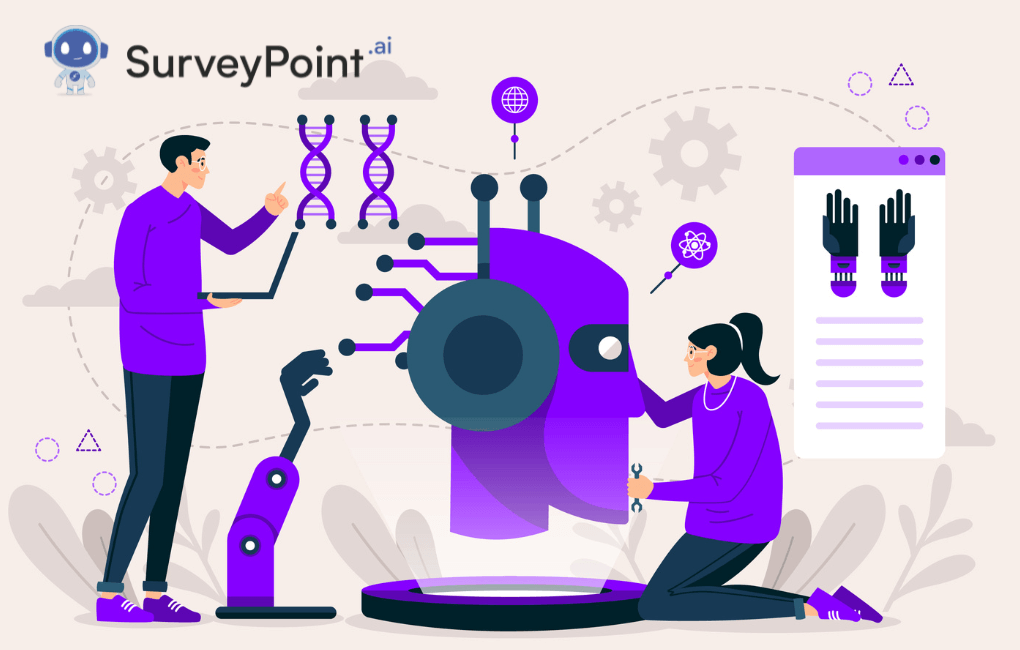
The existence of artificial intelligence is not new. Did you know that the first time modern AI made its way to humanity dates back to 1956? In the recent decade, it has found new popularity and use.
In today’s world, we are surrounded by AI not only outside but in our homes too. Turn on the lights, Alexa!
Just like any other field, management is changing and upgrading its current methods. To align to such new technological developments, we narrow down a few ways you can inculcate them in your business. Be it increasing the efficiency or making better decisions, many things will be accounted for.
Artificial Intelligence: What is it Exactly?
At its core, AI refers to machines or computer systems that can perform tasks that typically require human intelligence. These tasks, which include problem-solving, learning, and experiences, includes recognizing patterns, and making decisions. Unlike traditional programming, AI systems can adapt and improve over time, making them increasingly valuable in a wide array of applications.
Here’s a table outlining different types of AI, their brief histories, and the intentions behind their development:
| Type of AI | Brief History | Intent Behind Development |
| Expert Systems | Developed in the 1960s and 1970s | Intended to replicate human expert decision-making. |
| Natural Language AI | Emerged in the 1950s with early language translation. | Designed to understand and generate human language. |
| Neural Networks | Originated in the 1940s, gained traction in the 1980s. | Intended to simulate human brain for pattern recognition. |
| Genetic Algorithms | Introduced by John Holland in the 1960s. | Created to find optimal solutions through evolution. |
| Robotics AI | Gained prominence in the 1960s and 1970s. | Developed to enable machines to perform tasks physically. |
| Machine Learning | Conceptualized in the 1940s, popularized in the 1980s. | Aims to develop systems that can learn from data. |
| Reinforcement Learning | Traced back to early work in psychology in the 1950s. | Developed to create agents that learn from their actions. |
| Autonomous Vehicles | Evolved since the 1980s, with major advancements recently. | Intended to enable vehicles to navigate without human input. |
| Cognitive AI | Emerged in the 1950s and 1960s with AI pioneers. | Aims to mimic human cognitive processes and thinking. |
| Virtual Assistants | Gained prominence in the 2000s with speech recognition. | Created to provide interactive, human-like assistance. |
Artificial Intelligence Uses in Businesses
There are different types of artificial intelligence used in the world of business today and their everyday applications:
| Type of AI | Everyday Business Uses |
| Machine Learning | Forecasting trends and outcomes based on historical data.Dividing customers into groups for targeted marketing.Identifying suspicious patterns in financial transactions. |
| Natural Language Processing (NLP) | Handling customer inquiries and providing support. Analyzing customer feedback to gauge sentiment and improve services. Translating content for global audiences. |
| Computer Vision | Identifying objects and people in images for security and marketing purposes.Inspecting products for defects during manufacturing. Enabling self-driving cars with scene interpretation. |
| Robotic Process Automation (RPA) | Automating repetitive tasks like data entry and extraction.Streamlining invoice verification and payment processes. Automating employee onboarding processes. |
| Expert Systems | Assisting in complex decision-making by providing expert-like advice. Aiding medical professionals in diagnosing diseases and suggesting treatment options. Evaluating investment opportunities based on predefined rules. |
| Recommender Systems | Offering product or content recommendations based on user preferences and behavior. Tailoring news feeds or streaming playlists to individual tastes. Suggesting related products to increase sales. |
The Impact on Management
- Data-Driven Insights: AI’s ability to process vast amounts of data in real-time has revolutionized how businesses gather insights. Managers can now make informed decisions based on accurate data analysis, reducing the chances of relying on gut feelings.
- Enhanced Decision-Making: AI algorithms can sift through complex data sets, identifying trends and patterns that might go unnoticed by human analysts. This assists managers in making better decisions and devising strategies that are based on factual information.
- Predictive Analysis: One of the most significant advantages of AI is its predictive capabilities. By analyzing historical data, artificial intelligence can forecast trends and potential outcomes, enabling managers to proactively address challenges and seize opportunities.
- Streamlined Operations: Automation is a key aspect of AI. Routine tasks that would normally consume a significant amount of time can now be automated, freeing up managers to focus on higher-value tasks that require critical thinking and creativity.
- Personalized Customer Experience: AI-driven customer relationship management tools can analyze customer behavior and preferences. This enables managers to tailor marketing efforts and customer interactions, enhancing customer satisfaction and loyalty.
- Risk Management: AI can assess risks and vulnerabilities, allowing managers to develop strategies that mitigate potential issues. This is particularly valuable in industries like finance and cybersecurity.
- Employee Engagement and Productivity: AI-powered tools can monitor employee performance and provide personalized feedback, leading to better engagement and increased productivity. Additionally, AI chatbots can handle routine employee queries, further saving time for managers.
Challenges and Considerations
While AI offers tremendous benefits, its integration into management practices is not without challenges:
- Data Privacy and Ethics: Collecting and analyzing large amounts of data raises concerns about privacy and ethical use. Managers must navigate these issues to ensure responsible AI implementation.
- Skill Gap: The adoption of AI necessitates a workforce skilled in understanding and managing AI systems. Upskilling employees is crucial for a smooth transition.
- Initial Costs: Implementing AI systems can be expensive initially, requiring investments in technology and training. However, the long-term benefits often outweigh the initial costs.
- Human-Machine Collaboration: Striking the right balance between AI and human decision-making is a delicate task. Effective collaboration between humans and AI is vital for success.
The Future of AI in Management
The future of management undoubtedly includes a deeper integration of artificial intelligence. As AI continues to evolve, managers will witness:
- Routine tasks will become even more automated, allowing managers to focus on strategic planning and creative problem-solving.
- AI-driven analytics will become more sophisticated, providing managers with deeper insights and predictive capabilities.
- As AI becomes more pervasive, regulations and ethical considerations will become paramount. Managers will need to navigate these landscapes effectively.
- The systems of AI will become more collaborative, working alongside humans in a symbiotic relationship, enhancing productivity and decision-making.
Has AI Created More Jobs?
Yes, AI has the potential to create jobs in various sectors. Here are some points explaining how AI can lead to job creation, along with real-life brand examples:
- AI Development and Management:
Demand for AI experts, engineers, and developers to create, implement, and manage AI systems.
Example: Companies like OpenAI, Google, and Microsoft constantly hire AI engineers to develop and improve their AI technologies.
- AI Training and Annotation:
Creating and maintaining datasets for AI training requires data labeling and annotation, leading to jobs in data preparation.
Example: Appen and Lionbridge specialize in providing human-annotated data for training AI algorithms.
- Data Analysis and Interpretation:
AI generates vast amounts of data that need human analysis and interpretation for actionable insights.
Example: Data analysts at companies like Airbnb and Netflix analyze AI-generated user data to improve recommendations and user experiences.
- AI Integration and Support:
Businesses need AI integration specialists to seamlessly implement AI systems into existing workflows.
Example: IBM offers AI consulting and integration services, requiring specialists to customize AI solutions for clients.
- AI Monitoring and Maintenance:
AI systems require ongoing monitoring, maintenance, and troubleshooting, leading to roles in AI system management.
Example: Tesla employs engineers to monitor and maintain their AI-driven self-driving technology.
- AI Ethics and Regulation:
Growing concerns around AI ethics and regulations lead to the need for experts who can ensure responsible AI use.
Example: AI policy researchers and ethicists contribute to organizations like the Partnership on AI to develop ethical guidelines.
- AI Customer Interaction:
AI-powered customer service tools generate roles for AI trainers and supervisors.
Example: Zendesk’s AI-powered chatbots require human trainers to improve responses and train the AI models.
- Creative Content Generation:
AI-generated content can be refined and customized by human content creators, combining human creativity with AI efficiency.
Example: The New York Times uses AI tools to assist journalists in generating data-driven articles.
- AI Sales and Marketing:
AI-driven analytics create roles in interpreting data for sales and marketing strategies.
Example: HubSpot offers AI-powered marketing tools, requiring specialists to optimize campaigns based on AI insights.
- AI Education and Training:
AI’s expansion leads to a demand for educational programs, trainers, and courses to upskill the workforce.
Example: Udacity and Coursera provide AI-related courses, creating opportunities for instructors and trainers.
Wrapping Up
Whether we like it or, artificial intelligence is here to stay. Rather than seeing an aspect of technology against humanity, we have to work towards the same goal of improving ourselves and today’s management.
How long will this new management era last before we have another? That is still under speculation.




